Single-Shot Phase Measuring Profilometry Based on Quaternary Grating Projection
Abstract
1. Introduction
2. Principle
2.1. The Quaternary Grating Design Principle
2.2. Principle of Fringe Segmentation by Dynamic Threshold and Edge Detection
2.3. The PMP Based on the Proposed Quaternary Grating Projection Principle
3. The Experimental Results and Analysis
3.1. The Static Measurement Experiment
3.2. The Real-Time Online Measurement Experiment
3.3. Accuracy Analysis
4. Conclusions
Author Contributions
Funding
Institutional Review Board Statement
Informed Consent Statement
Data Availability Statement
Conflicts of Interest
References
- Geng, J. Structured-light 3D surface imaging: A tutorial. Adv. Opt. Photonics 2011, 3, 128–160. [Google Scholar] [CrossRef]
- Zhan, G.; Tang, H.; Zhong, K.; Li, Z.; Shi, Y.; Wang, C. High-speed FPGA-based phase measuring profilometry architecture. Opt. Express 2017, 25, 10553–10564. [Google Scholar] [CrossRef] [PubMed]
- Saxena, M.; Eluru, G.; Gorthi, S.S. Structured illumination microscopy. Adv. Opt. Photonics 2015, 7, 241–275. [Google Scholar] [CrossRef]
- Lee, H.; Kim, M.Y.; Moon, J.I. Three-dimensional sensing methodology combining stereo vision and phase-measuring profilometry based on dynamic programming. Opt. Eng. 2017, 56, 124107. [Google Scholar] [CrossRef]
- Xu, J.; Xi, N.; Zhang, C.; Zhao, J.; Gao, B.; Shi, Q. Rapid 3D surface profile measurement of industrial parts using two-level structured light patterns. Opt. Lasers Eng. 2011, 49, 907–914. [Google Scholar] [CrossRef]
- Vázquez, M.A.; Cuevas, F.J. A 3D Facial Recognition System Using Structured Light Projection. In Hybrid Artificial Intelligence Systems; Polycarpou, M., de Carvalho, A.C.P.L.F., Pan, J.S., Woźniak, M., Quintian, H., Corchado, E., Eds.; Springer: Cham, Switzerland, 2014; pp. 241–253. [Google Scholar]
- Jiang, C.; Lim, B.; Zhang, S. Three-dimensional shape measurement using a structured light system with dual projectors. Appl. Opt. 2018, 57, 3983–3990. [Google Scholar] [CrossRef]
- Chen, C.X. Discussion of: Testing strategy with multiple performance measures: Evidence from a balanced scorecard at Store24. J. Manag. Accoun. Res. 2015, 27, 67–73. [Google Scholar] [CrossRef]
- Zhang, S. Recent progresses on real-time 3D shape measurement using digital fringe projection techniques. Opt. Lasers Eng. 2010, 48, 149–158. [Google Scholar] [CrossRef]
- Van der Jeught, S.; Dirckx, J.J. Real-time structured light profilometry: A review. Opt. Lasers Eng. 2016, 87, 18–31. [Google Scholar] [CrossRef]
- Tao, T.; Chen, Q.; Da, J.; Feng, S.; Hu, Y.; Zuo, C. Real-time 3-D shape measurement with composite phase-shifting fringes and multi-view system. Opt. Express 2016, 24, 20253–20269. [Google Scholar] [CrossRef]
- Su, X.; Chen, W.; Zhang, Q.; Chao, Y. Dynamic 3-D shape measurement method based on FTP. Opt. Lasers Eng. 2001, 36, 49–64. [Google Scholar] [CrossRef]
- Li, B.; An, Y.; Zhang, S. Single-shot absolute 3D shape measurement with Fourier transform profilometry. Appl. Opt. 2016, 55, 5219–5225. [Google Scholar] [CrossRef] [PubMed]
- Zhang, S.; Van Der Weide, D.; Oliver, J. Superfast phase-shifting method for 3-D shape measurement. Opt. Express 2010, 18, 9684–9689. [Google Scholar] [CrossRef]
- Huang, P.S.; Hu, Q.; Jin, F.; Chiang, F.P. Color-encoded digital fringe projection technique for high-speed 3-D surface contouring. Opt. Eng. 1999, 38, 1065–1071. [Google Scholar] [CrossRef]
- Takeda, M.; Mutoh, K. Fourier transform profilometry for the automatic measurement of 3-D object shapes. Appl. Opt. 1983, 22, 3977–3982. [Google Scholar] [CrossRef] [PubMed]
- Zhang, Z.H. Review of single-shot 3D shape measurement by phase calculation-based fringe projection techniques. Opt. Lasers Eng. 2012, 50, 1097–1106. [Google Scholar] [CrossRef]
- Su, X.-Y.; Zhou, W.-S.; Von Bally, G.; Vukicevic, D. Automated phase-measuring profilometry using defocused projection of a Ronchi grating. Opt. Commun. 1992, 94, 561–573. [Google Scholar] [CrossRef]
- Ekstrand, L.; Zhang, S. Three-dimensional profilometry with nearly focused binary phase-shifting algorithms. Opt. Lett. 2011, 36, 4518–4520. [Google Scholar] [CrossRef]
- Li, B.; Fu, Y.; Wang, Z.; Zhang, J. High-speed, high-accuracy 3D shape measurement based on binary color fringe defocused projection. J. Eur. Opt. Soc. Rapid Publ. 2015, 10. [Google Scholar] [CrossRef]
- Zuo, C.; Chen, Q.; Gu, G.; Feng, S.; Feng, F.; Li, R.; Shen, G. High-speed three-dimensional shape measurement for dynamic scenes using bi-frequency tripolar pulse-width-modulation fringe projection. Opt. Lasers Eng. 2013, 51, 953–960. [Google Scholar] [CrossRef]
- Zuo, C.; Chen, Q.; Feng, S.; Feng, F.; Gu, G.; Sui, X. Optimized pulse width modulation pattern strategy for three-dimensional profilometry with projector defocusing. Appl. Opt. 2012, 51, 4477–4490. [Google Scholar] [CrossRef] [PubMed]
- Su, W.-H.; Chen, S.-Y. One shot projected fringe profilometry using a 2D fringe-encoded pattern. In Photonic Fiber and Crystal Devices: Advances in Materials and Innovations in Device Applications XII; International Society for Optics and Photonics: Bellingham, WA, USA, 2018; Volume 10755, p. 1075511. [Google Scholar] [CrossRef]
- Cheng, N.J.; Chen, S.Y.; Su, W.H. Profile measurements using contrast-encoded pattern projections. In Photonic Fiber and Crystal Devices: Advances in Materials and Innovations in Device Applications XIII; International Society for Optics and Photonics: Bellingham, WA, USA, 2019; Volume 11123, p. 111230U. [Google Scholar]
- Chen, X.; Wang, Y.; Wang, Y.; Ma, M.; Zeng, C. Quantized phase coding and connected region labeling for absolute phase retrieval. Opt. Express 2016, 24, 28613–28624. [Google Scholar] [CrossRef] [PubMed]
- Heist, S.; Mann, A.; Kühmstedt, P.; Schreiber, P.; Notni, G. Array projection of aperiodic sinusoidal fringes for high-speed three-dimensional shape measurement. Opt. Eng. 2014, 53, 112208. [Google Scholar] [CrossRef]
- Fu, G.; Cao, Y.; Wang, Y.; Wan, Y.; Wang, L.; Li, C. Real-time three-dimensional shape measurement based on color binary fringe projection. Opt. Eng. 2019, 58, 044102. [Google Scholar] [CrossRef]
- Ma, Q.; Cao, Y.; Chen, C.; Wan, Y.; Fu, G.; Wang, Y. Intrinsic feature revelation of phase-to-height mapping in phase measuring profilometry. Opt. Laser Technol. 2018, 108, 46–52. [Google Scholar] [CrossRef]


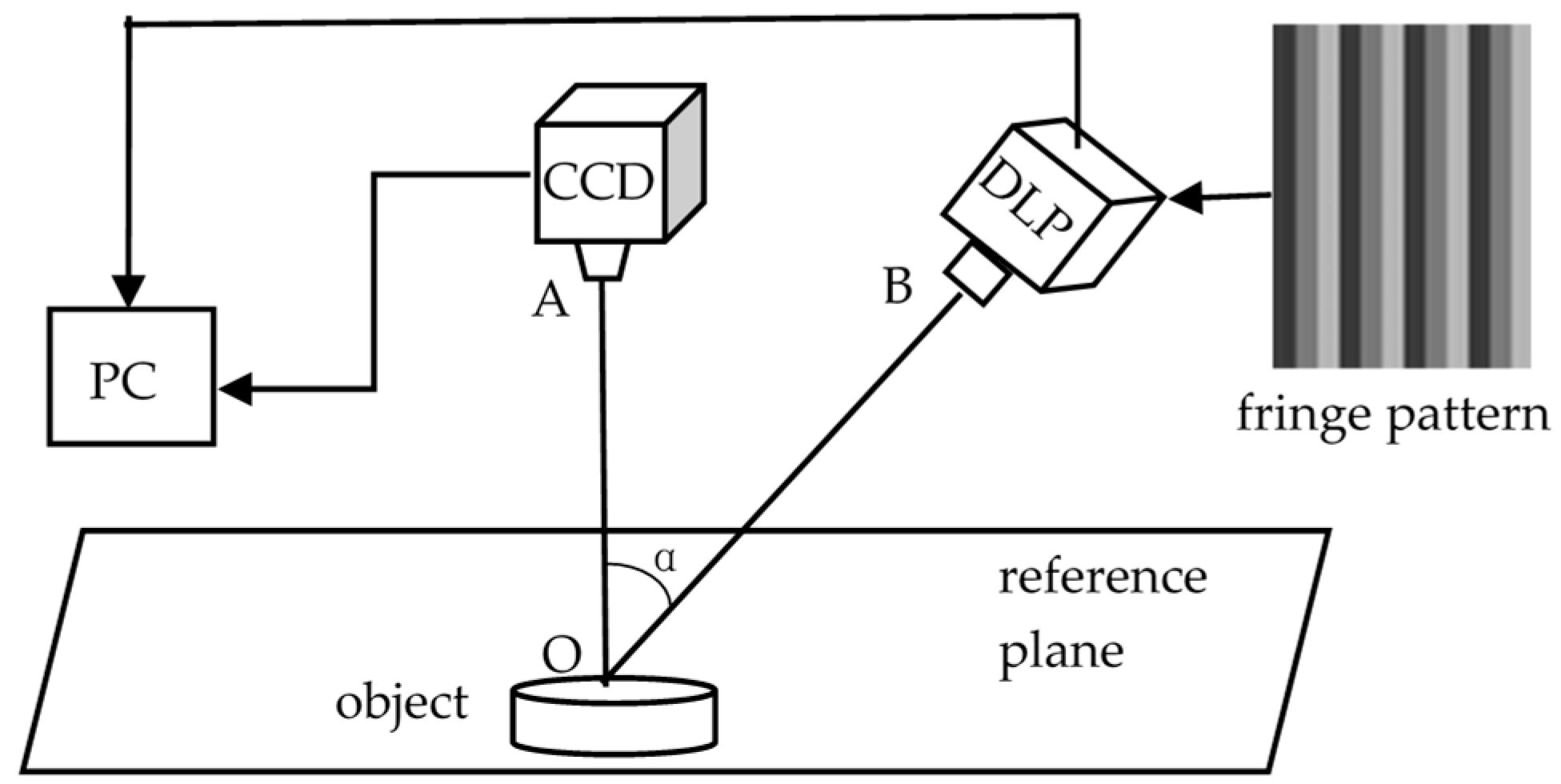
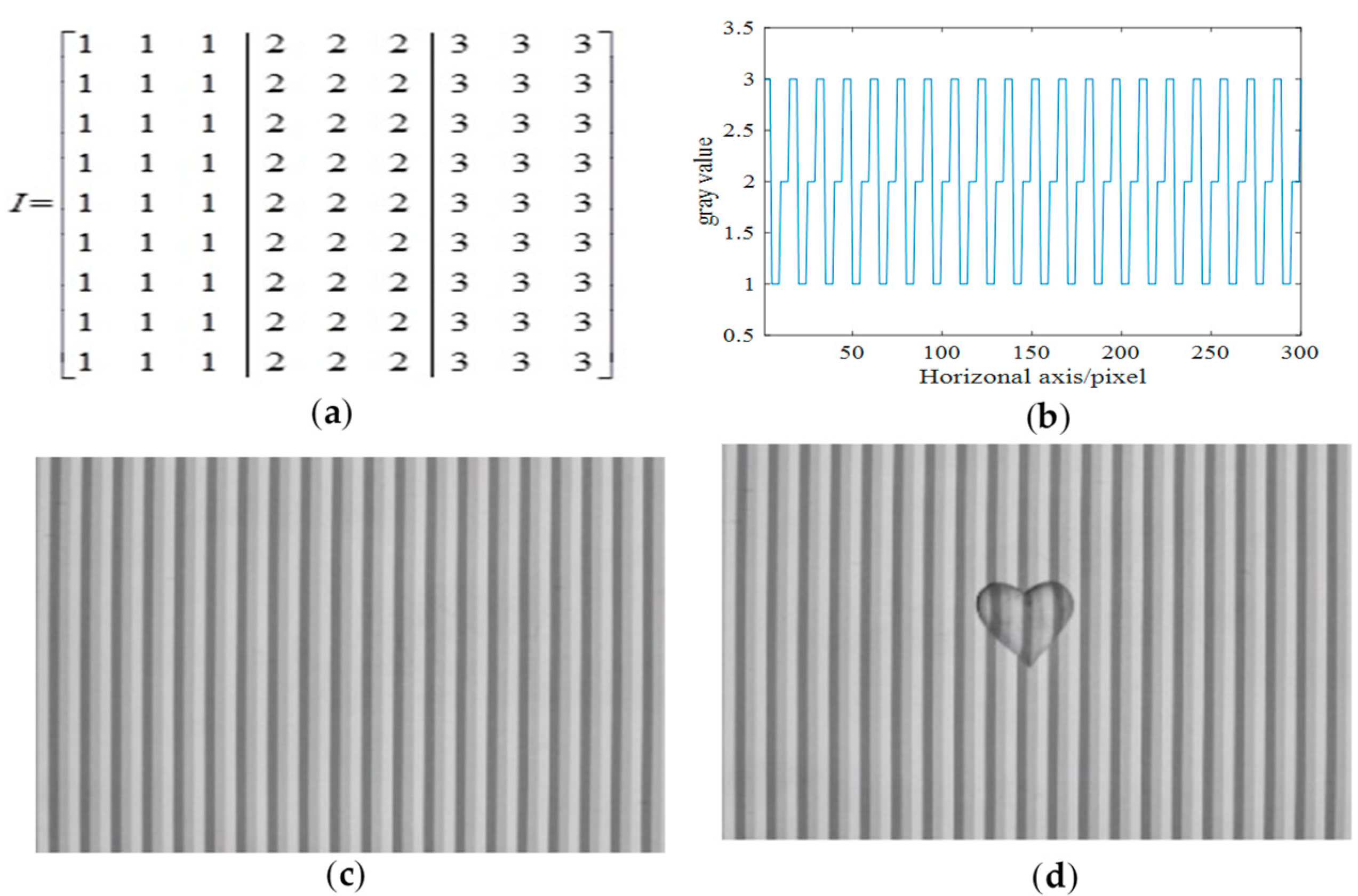
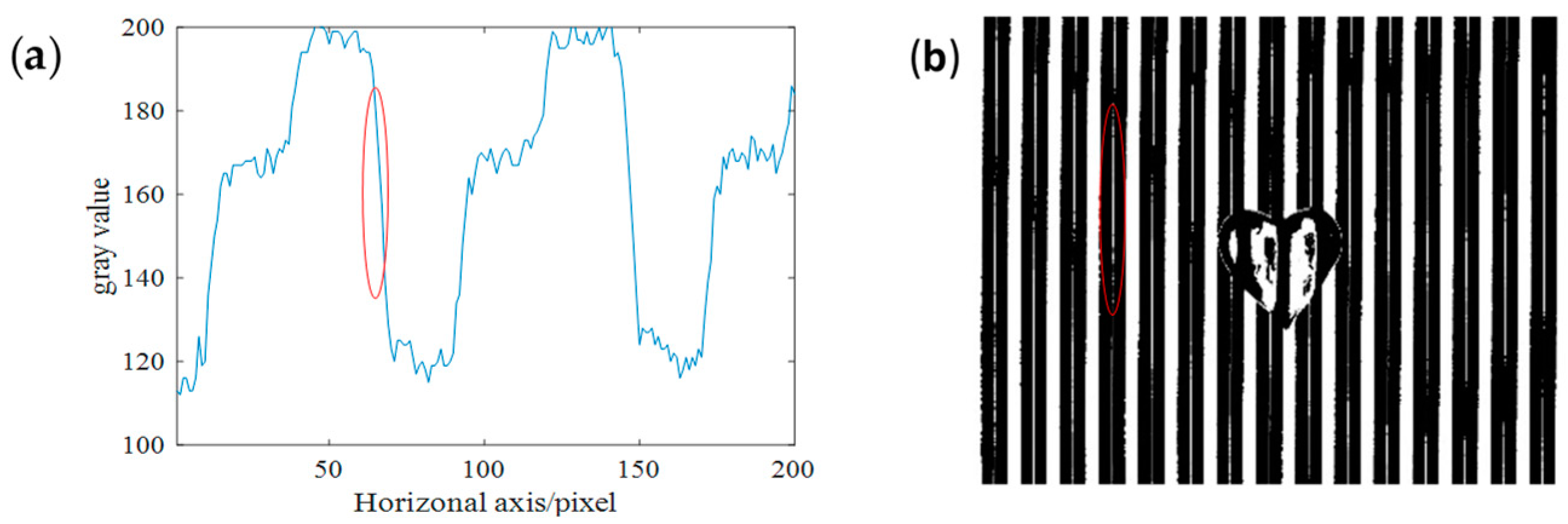
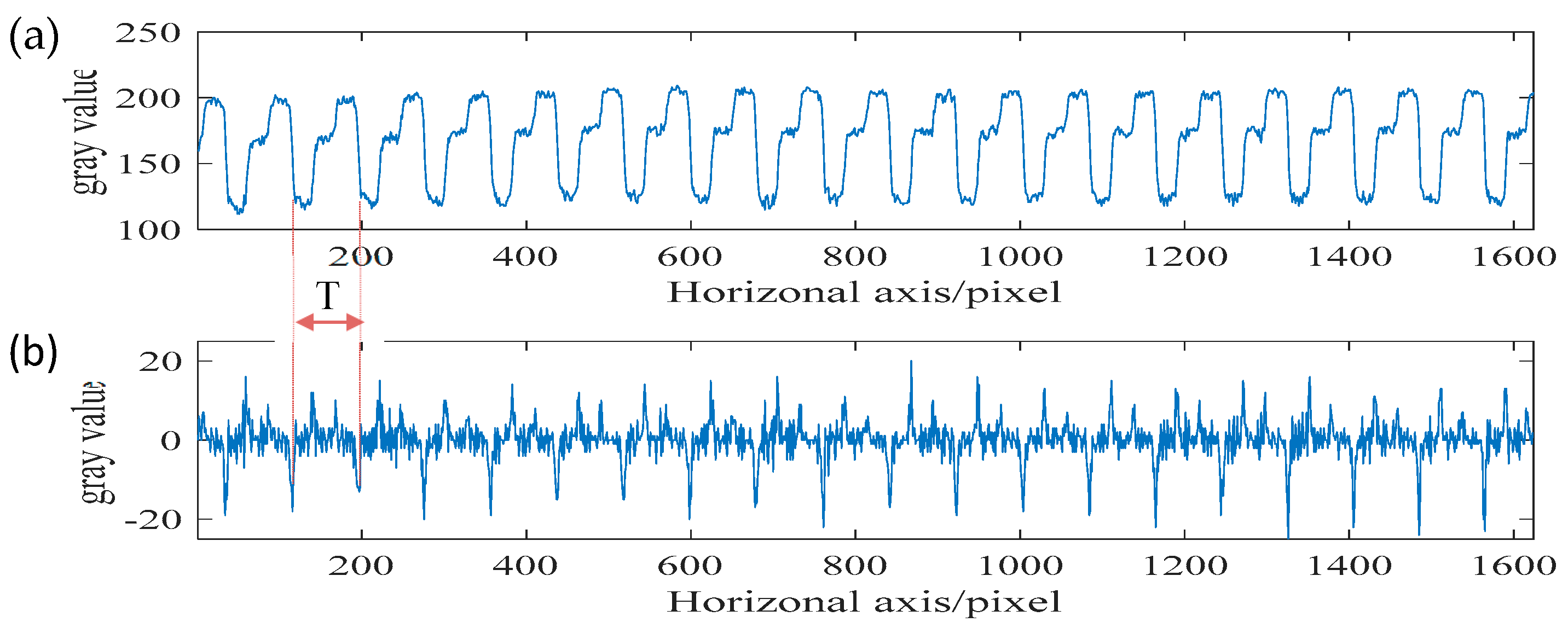

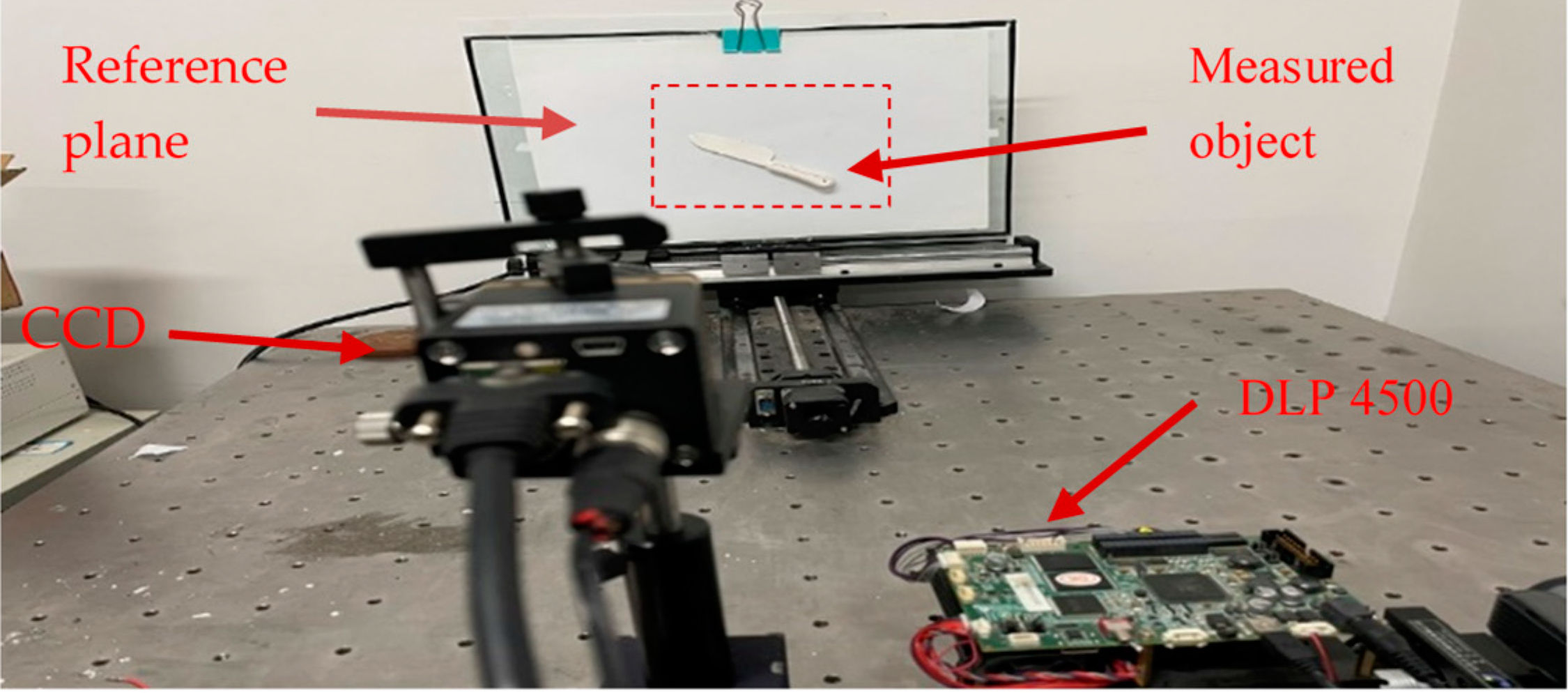
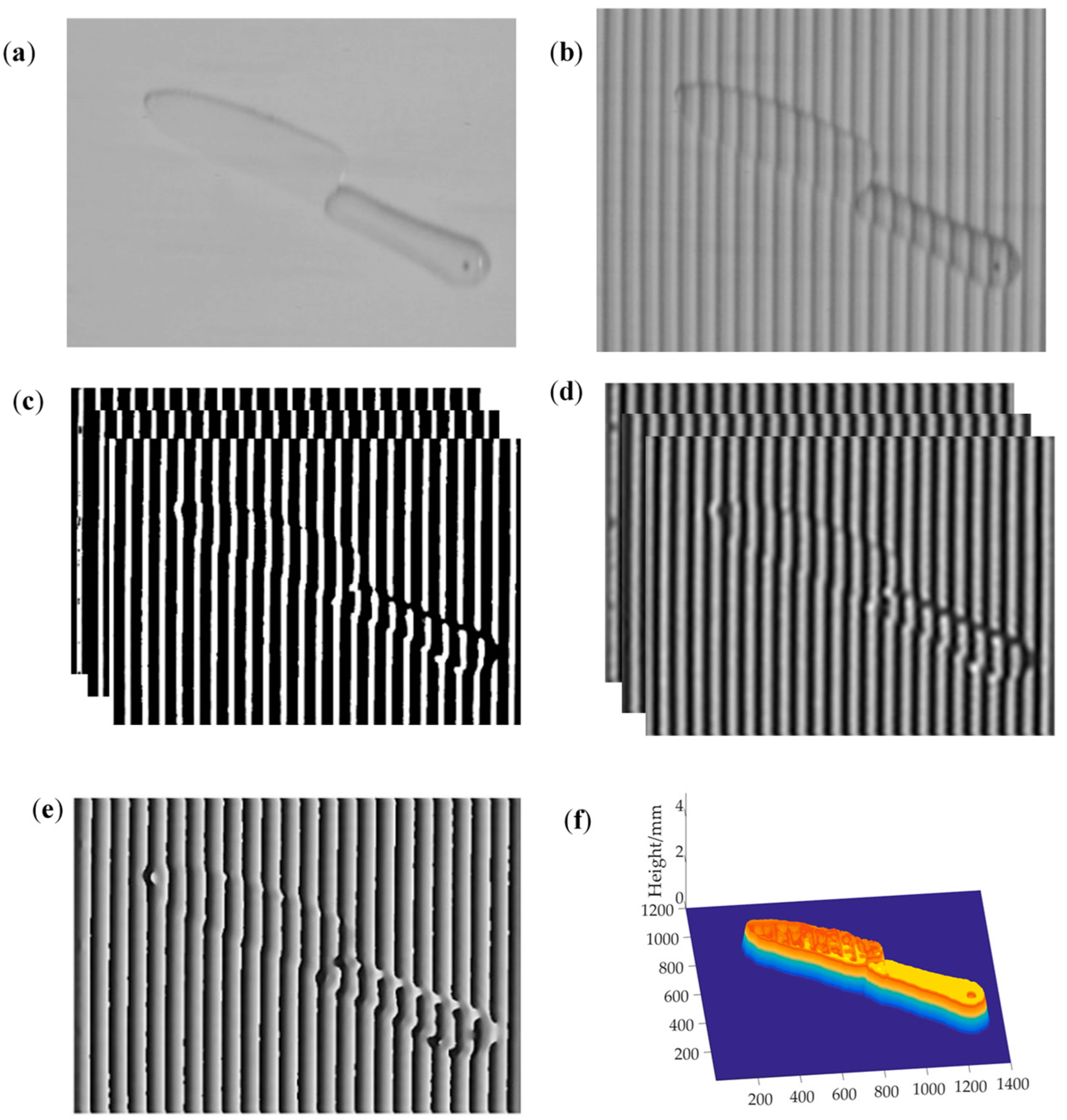
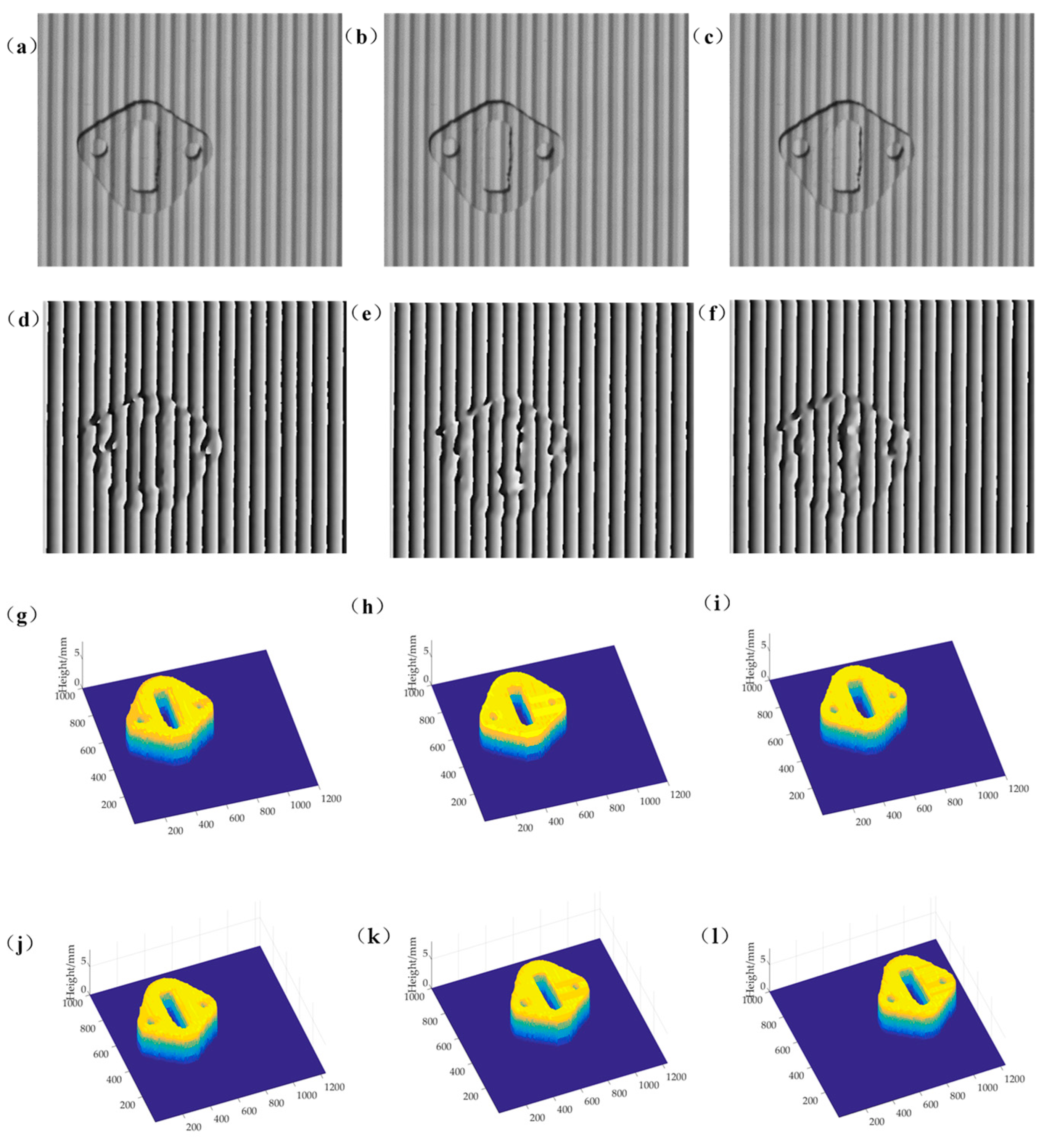
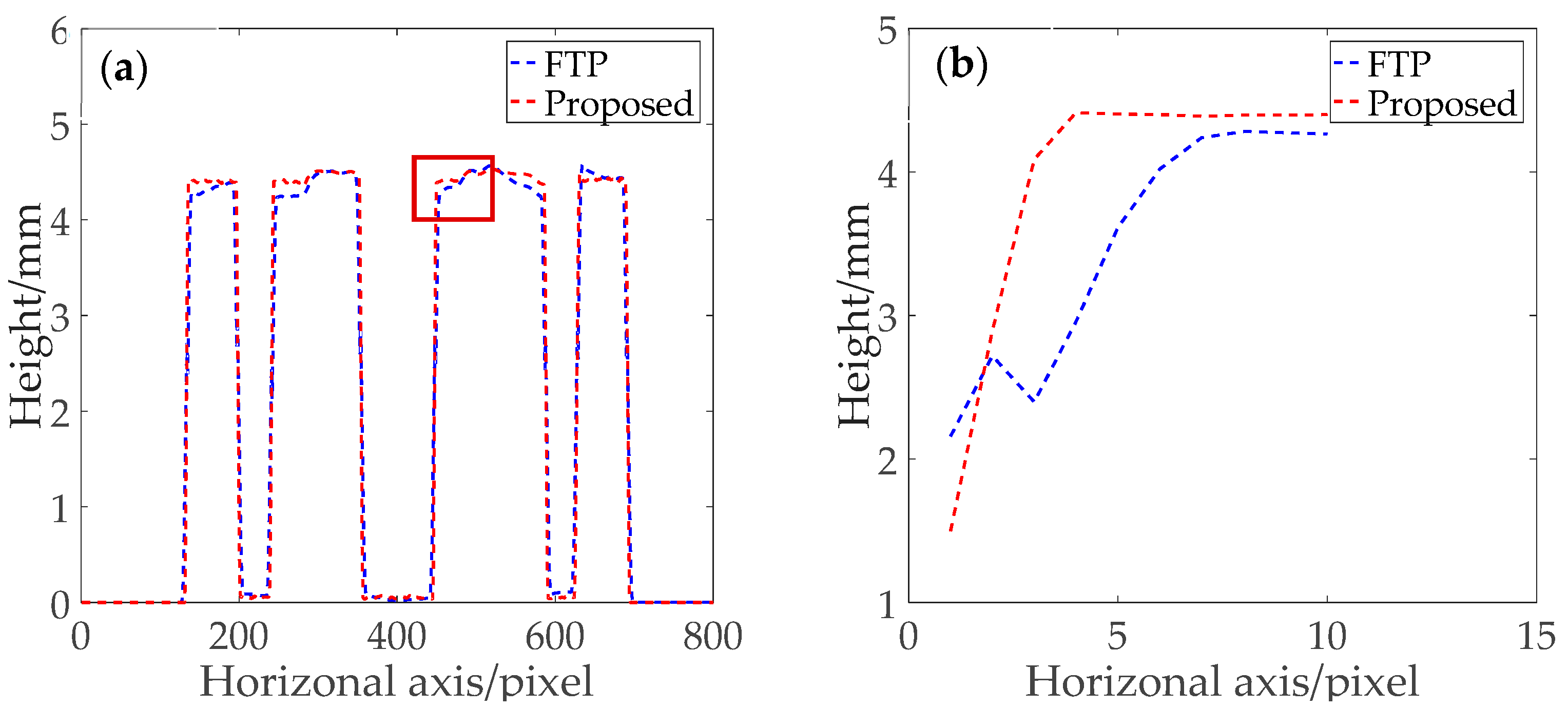
| Moving Speed (mm/s) | 5 | 10 | 20 | 30 |
|---|---|---|---|---|
| RMSE (mm) | 0.034 | 0.037 | 0.045 | 0.048 |
Publisher’s Note: MDPI stays neutral with regard to jurisdictional claims in published maps and institutional affiliations. |
© 2021 by the authors. Licensee MDPI, Basel, Switzerland. This article is an open access article distributed under the terms and conditions of the Creative Commons Attribution (CC BY) license (http://creativecommons.org/licenses/by/4.0/).
Share and Cite
Yang, C.; Cao, Y.; Huang, X. Single-Shot Phase Measuring Profilometry Based on Quaternary Grating Projection. Appl. Sci. 2021, 11, 2536. https://doi.org/10.3390/app11062536
Yang C, Cao Y, Huang X. Single-Shot Phase Measuring Profilometry Based on Quaternary Grating Projection. Applied Sciences. 2021; 11(6):2536. https://doi.org/10.3390/app11062536
Chicago/Turabian StyleYang, Chaozhi, Yiping Cao, and Xiuzhang Huang. 2021. "Single-Shot Phase Measuring Profilometry Based on Quaternary Grating Projection" Applied Sciences 11, no. 6: 2536. https://doi.org/10.3390/app11062536
APA StyleYang, C., Cao, Y., & Huang, X. (2021). Single-Shot Phase Measuring Profilometry Based on Quaternary Grating Projection. Applied Sciences, 11(6), 2536. https://doi.org/10.3390/app11062536






